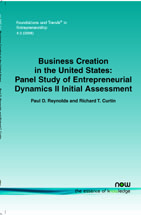Business Creation in the United States: Panel Study of Entrepreneurial Dynamics II Initial Assessment
By Paul D. Reynolds, Florida International University, USA, pauldreynolds@earthlink.net | Richard T. Curtin, University of Michigan, USA, curtin@umich.edu
Abstract
PSED II began in 2005 with the selection of a cohort of 1,214 nascent entrepreneurs chosen from a representative sample of 31,845 adults. The first 12 month follow-up interviews were completed with 80% of the original cohort. The project is designed to replicate, with appropriate methodological improvements, PSED I. The PSED provides a unique, unprecedented description of the initial stages of the entrepreneurial process. The results suggest that prior experience and an appropriate strategy are critical for completing a new firm birth; personal attributes, motivations, and contexts seem to have minimal effect. The PSED findings have substantial implications for policy makers who wish to improve the capacity of the US entrepreneurial sector to confront global competitive threats with a steady flow of new and innovative firms.
Business Creation in the United States
Business creation is a central feature of entrepreneurship, facilitating job creation, economic innovation, and improved sector productivity. Business Creation in the United States presents the results of PSED II and is designed to provide an introductory overview to the research project and describe the major results. The project is designed to replicate, with appropriate methodological improvements, PSED I. The PSED provides a unique, unprecedented description of the initial stages of the entrepreneurial process. The results suggest that prior experience and an appropriate strategy are critical for completing a new firm birth, while personal attributes, motivations, and contexts seem to have minimal effect. Business Creation in the United States has substantial implications for policy makers who wish to improve the capacity of the US entrepreneurial sector to confront global competitive threats with a steady flow of new and innovative firms. Emphasis has been placed on the scope of activity and the most important policy implication. Business Creation in the United States is designed to provide an overview which can form the basis for exploring more specific issues in detail, issues with relevance to specific theories or conceptual frameworks.
